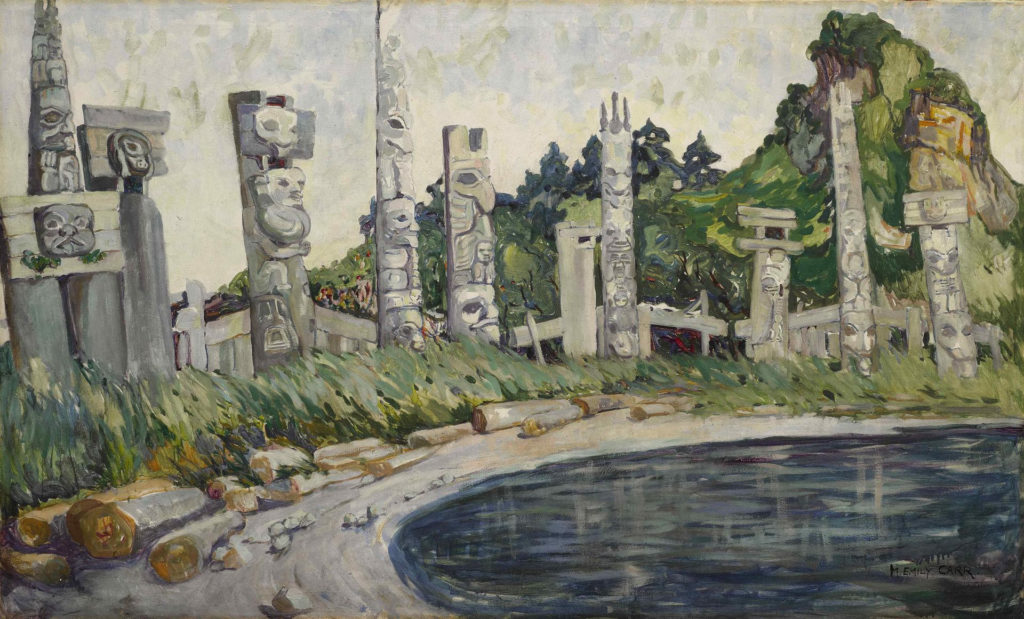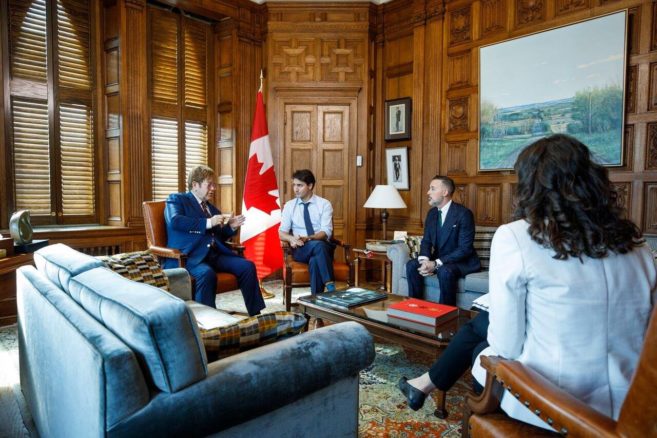It was touted by Sotheby’s as “a rare monumental masterpiece”: a 1912 Emily Carr painting called Skedans, after the Haida Gwaii village it depicts. Featuring several totem poles against a mottled sky, it was offered at Sotheby’s New York last month, estimated at US$3 to 5 million. It failed to sell at public auction, though Sotheby’s confirms it sold privately to a collector afterward.
For some, a public sale on the international art market of a work of this nature by a Canadian artist is cause for celebration. (This was the first time Sotheby’s offered a work by Carr outside Canada.)
For others, questions remain. How did the work leave Canada in the first place? Sotheby’s called it “an exceptional Canadian masterpiece.” Wouldn’t it then have qualified as a national treasure? There are rules in Canada on the export of cultural property, after all. And it appears from this auction—as well as other recent events, including the fact that the Globe and Mail reported there was an error on the Skedans export permit—that those rules need to be fixed, and soon.
Anyone who tries to take important artwork of a certain type out of Canada needs an export permit from a federal officer. A painting like Skedans—worth more than $15,000 by a deceased Canadian artist and more than 50 years old—requires a permit.
Sotheby’s has confirmed that the seller, who acquired the work in 1999 from a Canadian private collection, had the necessary export documentation. The Department of Canadian Heritage says an export permit for Skedans was indeed obtained a few months prior to the auction, in June 2019.
There is a review process that can result in artworks being bought by Canadian institutions from an exporter and kept in the country—“saved for the nation” as it’s sometimes called. But it didn’t seem to work in this case.
Here’s how the process is supposed to operate according to federal legislation called the Cultural Property Export and Import Act: before a Canadian officer issues an export permit, details of the relevant artwork are forwarded to an “expert examiner”—usually a senior curator or academic. The expert examiner determines whether the work is (A) of “outstanding significance” by reason of its close association with Canadian history or national life, its aesthetic qualities or its value for study and (B) of “national importance” to such a degree that its departure would significantly diminish the national heritage.
If the expert examiner finds the artwork to be both (A) and (B), an export permit will not be issued. A prospective exporter can then have that finding reviewed by the Canadian Cultural Property Export Review Board. If the Board agrees with the examiner, it can impose a delay of two to six months, during which Canadian art institutions can attempt to purchase the work. If no fair market offer is made within that window, an export permit is issued. Likewise, if the Board doesn’t think the artwork is of either “outstanding significance” or “national importance,” the permit is issued.
Remarkably, Skedans did not go before the Board prior to leaving. This means the expert examiner who evaluated the work in June thought this “exceptional Canadian masterpiece” (to use Sotheby’s words) somehow lacked either “outstanding significance” or “national importance.”
I’m not an art historian and would be loath to second-guess an expert examiner. However, the forthright issuance of an export permit for this “monumental masterpiece” seems peculiar. Had the examiner determined otherwise, it would’ve at least given Canadian institutions the opportunity to acquire the piece for public collections.
The problems with Canada’s art export system don’t end there.
In early 2018, a work by Marc Chagall, La Tour Eiffel (1929), was easily bestowed with an export permit, despite the fact that (while not by a Canadian artist) it had been in the collection of the National Gallery of Canada for more than 60 years. Apparently being in the collection of the country’s leading art institution, and significantly displayed there, does not qualify a work for “outstanding significance” and “national importance.” (This result is especially perplexing when we consider that the National Gallery is endowed with federal funds every year specifically to acquire works of great importance to the country.)
In the summer of 2017, the Board considered the possible export of a painting by French artist Gustave Caillebotte, a work that had been in a private collection since its arrival in Canada and had almost never been publicly displayed. Rather incredibly—when considering the above two examples—this painting was considered to be of “outstanding significance” and “national importance.” A challenge to the decision was brought through the courts, but ultimately the Federal Court of Appeal confirmed the Board’s stance in April 2019.
If the Caillebotte was of “outstanding significance” and “national importance,” why not the Chagall, or indeed the Carr?
There’s nothing inherently wrong with expert examiners taking a tough stance when measuring artworks for “outstanding significance” and “national importance.” It might mean that more works like Skedans get out of Canada and onto the global market, helping the overall promotion of Canadian artists and subjects.
But the actual application of criteria for “outstanding significance” and “national importance” under the federal law is massively skewed.
In 2015–16 (the latest year for which figures are publicly available) only seven cultural objects and collections out of 359 applications were brought before the Board to be evaluated for export on these criteria. During that time, the Board pronounced a staggering 6,608 cultural objects and collections to meet those same criteria—but for income tax purposes.
If someone donates art to a qualifying institution and gets the art certified as “cultural property” by the Board, they can offset their income tax that year, in some cases by as much as 100 per cent. This leads to tax benefits that reach (in my estimation) some $100 million in a given year.
Basically, in the last year for which data is available, expert examiners found roughly two per cent of export artworks to be of “outstanding significance” and “national importance,” while the Board found more than 80 per cent of tax-credit artworks to be so.
Why such lopsided results? The answer might have to do with the incredibly generous tax benefits associated with the certification of cultural property in Canada.
In short, the art export system under federal law has become a relatively unobtrusive sideshow to the Board’s de facto raison d’être: the issuance of major tax credits.
Currently in Canada, an impressive work like Skedans can slip through the export net, while each year thousands of cultural objects get granted “cultural property” status for tax certification. Though the public cannot know for certain—the details of works given tax certification by the Board are not published—an educated guess would say that more than a few of the 6,608 certified works in 2015–16 were not quite Skedans calibre. In fact, probably the vast majority.
This imbalance is even more glaring when compared internationally. The UK’s Cultural Gifts Scheme, for example, is broadly comparable to Canada’s tax certification system, though by no means as generous to donors. Nevertheless the UK system designates only a handful of items or collections per year (in 2015–16 there were 13)—a far cry from the many thousands of items or collections designated in Canada every year.
The problem is that we have a system in Canada that grew unevenly and unchecked since the 1970s—one that incentivizes tax writeoffs and leaves the majority of the export system in relative neglect. The criteria for expert examiners assessing exports was meant by law to be identical to those the Board uses to certify cultural property for tax certification—at least until March of this year, when the federal government decided to make it even easier for the Board to grant tax certification, a decision that will only accentuate the imbalance.
The conclusion we can draw from all this is that the criteria in Canada’s Cultural Property Export and Import Act has not been uniformly applied. And that doesn’t adhere to the policy behind the Act: expert examiners and the Board were meant to apply identical criteria.
The end result is that a work like Skedans has a chance to slip out of the country, while a great many lesser works remain inside—lodged in our museums as ballast for a tax scheme more lucrative than most of us could ever imagine.
This text was updated slightly on December 18, 2019. A reference to “the Globe” was changed to “the Globe and Mail,” and an external link was added for that newspaper article.

 Emily Carr, Skedans, 1912. Oil on canvas, 89.5 x 148 cm. Photo: Sotheby's.
Emily Carr, Skedans, 1912. Oil on canvas, 89.5 x 148 cm. Photo: Sotheby's.







